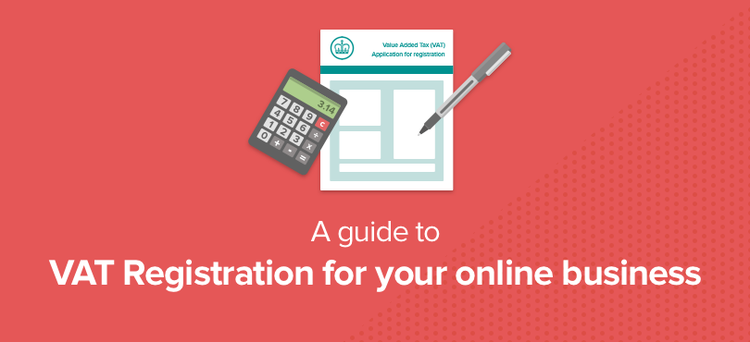A guide to VAT registration for your online business

When a business reaches a certain size, they’re required by law to start charging VAT on all their sales and pay this money to HMRC. Registering for VAT requires you to keep records and submit VAT returns, but it also enables you to claim back VAT that you pay on purchases you make for your business. We take a look at what VAT is, when and how you can register, and how you can reclaim VAT on business-related purchases.
What is VAT?
Value Added Tax is a type of consumption tax, charged on the sale of goods and services in the UK. It’s charged as a percentage of the total cost of an item or service, currently, VAT is 20% for most items. The VAT charged to a business’s customers is then paid to HMRC when you complete your VAT return, and you can reclaim VAT that you’ve paid on business related goods or services.
Some items and services charge VAT at a reduced rate of 5%, and some are zero-rate VAT but these still have to be recorded in VAT accounts and included in your VAT returns. Find out more about the different VAT rates.
When do you need to register for VAT?
You need to register for VAT with HMRC if your business’s VAT taxable turnover goes over £85,000 in a rolling 12 month period (the threshold usually increases on 1 April each year). However, if neither you or your business is based in the UK there is no threshold and you must register for VAT as soon as you supply any goods or services to the UK. You can also voluntarily register for VAT before you reach the threshold.
VAT taxable turnover is the total value of everything you sell that isn’t exempt from VAT.
Once your business has passed the £85,000 threshold you must register for VAT within 30 days. If you miss that deadline then you will have to pay the VAT that you owe from when you should have registered and, depending on how much you owe and how late you register, you could also have to pay a penalty.
If your taxable turnover only goes over the threshold temporarily then you can write to HMRC and apply for an ‘exception’ from paying VAT. To de-register for VAT your turnover has to fall below £83,000, and to apply for an ‘exception’ you have to provide evidence that your business won’t go over that threshold in the next 12 months.
How do you register for VAT?
To register for VAT you’ll need to provide HMRC with details about your business such as trading name, incorporation details, business activity, turnover, bank details and contact details.
Sole traders, Limited Companies and partnerships are able to register for VAT online here. You’ll be able to register for VAT and create a VAT online account (or Government Gateway account). You can also use an accountant (agent) to register and submit your VAT returns.
Once you’ve registered you should get a VAT registration certificate within 14 working days (but it can take longer) either to your VAT online account or by post if an accountant registers you or you can’t register online.
Your registration date is the date that you apply to register; known as your ‘effective date of registration’, and you will pay VAT from this date so it’s important that you keep VAT records from then.
Find out more about registering for VAT here.
How do you claim back VAT?
If you or your company is VAT registered, and you pay VAT for goods or services that you purchase, then you’re able to claim the VAT back from HMRC.
As a VAT registered company you need to keep VAT accounts, and then you will have to complete a VAT return, usually every three months. The VAT return tells HMRC the amount of VAT that you have charged on what you sell, and how much VAT you have paid on purchases for your business.
If you’ve charged more VAT than you’ve paid, you have to pay the difference to HMRC. If you’ve paid more VAT than you’ve charged, you can reclaim the difference from HMRC. You’ll need to submit a VAT return even if you don’t owe any VAT or need to reclaim any.
Most accounting software that you might be using to keep your financial records will let you submit a VAT returns directly to HMRC.
You can also claim back VAT for purchases made before you registered. You can reclaim VAT for goods purchased up to four years before registration as long as you still have them, or they were used to make other goods that you still have, and you can reclaim VAT for services purchased up to six months before. You can only make backdated claims for goods or services that were specifically purchased for the business that is now VAT registered, and you have to have the appropriate records to include in your first VAT return.
Find out more about VAT returns.

